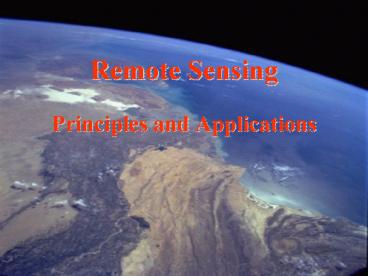Remote Sensing - PowerPoint PPT Presentation
1 / 17
Title:
Remote Sensing
Description:
Why should a Geomatics student study it? Remote Sensing, Principles ... Lillesand and Kiefer Remote sensing and Image Interpretation. 2nd Ed. Wiley and sons. ... – PowerPoint PPT presentation
Number of Views:290
Avg rating:3.0/5.0
Title: Remote Sensing
1
Remote Sensing
- Principles and Applications
2
Remote Sensing
- What is Remote sensing?
- Why should a Geomatics student study it?
3
Remote Sensing, Principles and Applications
- INTRODUCTION
- Course Objectives
- Syllabus
- Course Outline
- Assessment
- Texts
4
Remote Sensing, Principles and Applications
- Course Objectives
- To develop an understanding remotely sensed
imagery in relation to its - 1. Acquisition
- 2. Processing
- 3. Interpretation and
- 4. Application
5
Remote Sensing, Principles and Applications
- Syllabus
- Section One
- Principles of remote sensing
- Human vision and image interpretation
- The nature of electromagnetic radiation
- . Spaceborne and airborne sensors.
6
Remote Sensing, Principles and Applications
- Syllabus
- Section Two
- An introduction to digital image processing
including - 1.Stretching,
- 2.Digital filters,
- 3.Arithmetic manipulations,
- 4.Image classification.
7
Remote Sensing, Principles and Applications
- Syllabus
- Section Three
- Applications
- Environmental
- Geological
- Marine
- Planning
8
Remote Sensing, Principles and Applications
- Course Outline
- 1 Introduction to the course.
- Spare
- 2 Human vision /Electromagnetic radiation.
- spare
- 3 Major satellite systems /Image Display.
- Image Display
- 4 Image stretching / Arithmetic manipulations.
- Image stretching
9
Course Outline
Remote Sensing, Principles and Applications
- 5 Digital spatial filters / Rectification.
- Image ratio prac
- EASTER BREAK
- 6 Classification.
- Filter Prac
- 7 Geological Applications.
- Classification Prac 1
- 8 Vegetation Mapping
- Classification Prac 2
10
Course Outline
Remote Sensing, Principles and Applications
- 9 Environmental Monitoring/ Oceanography.
- Literature review
- 10 Marine Applications.
- Literature review
- 11 Military Applications/Disaster Management.
- Literature review
- 12 Remote Sensing Ethics / Revision
11
Remote Sensing, Principles and Applications
- Assessment
- Two hour exam 60
- Literature review of a selected application
area 10 - Weekly exercise reports 30
12
Remote Sensing, Principles and Applications
- Assessment
- Weekly exercise reports
- Five reports
- A minimum of 500 words
- Discuss the exercise - not just report it.
- Due in the Friday of that week.
13
Remote Sensing, Principles and Applications
- Assessment
- Literature review of a selected application area
- Normal essay format, 1000 words
- Minimum of five (5) references including at
least two (2) journal papers. - Due last Friday of semester - May 28
14
Remote Sensing, Principles and Applications
- Literature review of a selected application area
- Introduction
- Give brief introduction to area
- Analysis
- Brief analysis of each paper or reference
- Summary
- Synthesis of the state of the art
- Discuss capabilities and limitations
- Conclusion
- Future development
15
Remote Sensing, Principles and Applications
- Literature review of a selected application area
- Suggested Topics -
- Hazard mapping - Fire, Oil spill etc.
- Urban planning
- Environmental monitoring - ozone layer, snow
and ice mapping, oceans etc. - Crop assessment
- Sea floor mapping
- Any other application
16
Remote Sensing, Principles and Applications
- Image Processing System
- TNT Lite
- Freeware
- Recommend 32m RAM
- Borrow the disc
- Web site http//www.microimages.com
- E-mail info_at_microimages.com
- Address Microimages Inc.
- 201 North 8th Street
- Lincon, NE 68508-1347
- USA
17
Remote Sensing, Principles and Applications
- Recommended Text
- Sabins Remote Sensing - Principles and
Interpretation 3rd Ed. Freeman - Other Suggested Texts
- Jensen Introductory Digital Image Processing- A
Remote Sensing Perspective. 2nd Ed. Prentice Hall - Lillesand and Kiefer Remote sensing and Image
Interpretation. 2nd Ed. Wiley and sons. - Drury Image Interpretation in Geology Allen and
Unwin































